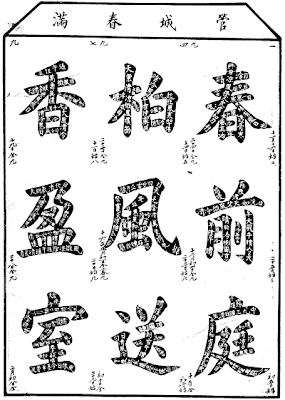九九消寒图jiǔjiǔxiāohántú, the timing of 9 times 9 days, or the timing of winter, is a sheet on which the Chinese have the 81 days of winter until the spring.
The Jiǔ, number 9, is a unit of time. From the day of Dongzhi冬至, the winter solstice, all the 9 days is a cycle "Jiǔ" until the day惊蛰Jingzhi, "awakening of insects", which is the return of spring. It is often said that the first 3 Jiǔ (corresponding to the month following that of Dongzhi) is the most severe of the year. A Chinese folk song says, "9 the first two, hands in your pocket. The 3rd and 4th, we walk on the ice. The 5th and 6th, the ground weeping germination. The 7th 9, the water again to sink. The 8th 9, swallows return. 9 The 9th past, cattle work. " Of course, due to a climatically diverse, the songs and proverbs vary in each region according to local circumstances.
The schedule of 9 days after 9 "is more often in the form of a sheet with 9 Chinese characters, each of which is composed of 9 features. Every day we completed a line from the day of Dongzhi, so 9 characters will be completed by the end of 9 Jiǔ, the day of Jingzhi. Traditionally, the strokes are filled with different colors corresponding to the time of the day: red for sunny, blue for cloudy, green for the rain, the yellow wind, and white for the snow (on may leave blank or put the powder of lead). Sometimes we also completed the deal directly with a small summary of the weather early days in writing (image below). This calendar of "9 times 9 can also serve as a compendium of data meteoric.
.gif)
A 2nd method of counting the 81 days (very rare) is the design of Prunus mume or梅méi. This tree blooms in winter is the symbol of virtue in traditional Chinese culture. The design is composed of 9 parts of "mei", each containing 9 buds. Were replaced daily by a flower bud throughout the 81 days of the cycle.
A 3rd method is to fill in the circles of pre-designed calendar. It fulfilled a part of the circle to indicate the time of day. Blackened circles on the way: the top half of a sunny day, the bottom half for a cloudy day, half left for a windy day, half to right for a rainy day, and a point in the middle for snow .
Below is an example of schedule 9 times 9溥仪Pǔyí completed by the last emperor of China. This calendar is divided into 9 frames, each contains 9 symbols Taiji太极open in different directions. In this example, the Yin (white) of Taiji is considered as empty, ie not half filled. The use of Taiji is probably related to the status of imperial family.

No comments:
Post a Comment